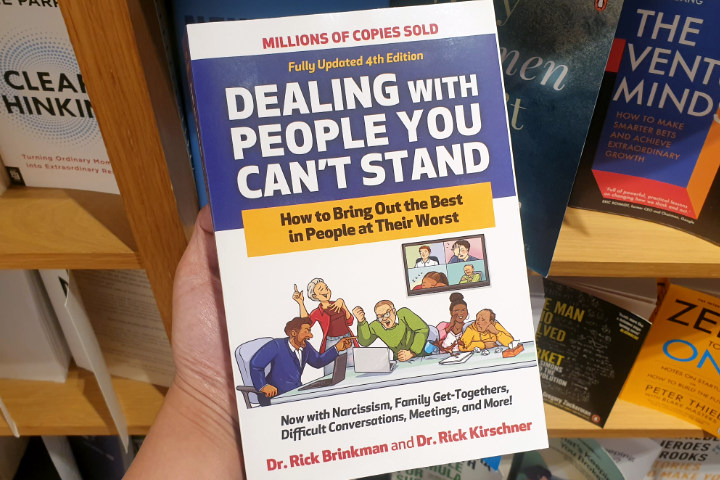Learn effective strategies to handle difficult people with confidence. Understand their behaviors, improve communication skills, and create positive interactions, turning challenging relationships into opportunities for growth and understanding.

In the realm of interpersonal dynamics, few challenges are as universally relatable as the struggle to navigate interactions with difficult individuals.
Rick Brinkman and Rick Kirschner’s “Dealing with People You Can’t Stand” emerges as an essential guide for those seeking to transform adversarial encounters into opportunities for constructive communication.
With a blend of humor, empathy, and strategic insight, the sharp-witted authors offer readers a roadmap for understanding and managing the challenging personalities that inevitably cross our paths.
This work transcends the usual self-help genre by blending insight with actionable advice, making it a resource worth returning to. Especially for those in leadership roles or anyone who finds themselves regularly grappling with people whose behavior tests their patience.
The book begins by inviting readers to shift their perspective on difficult people.
The authors propose that these individuals, rather than being obstacles, are opportunities for personal growth and improved communication skills.
By reframing our approach to challenging interactions, we can cultivate a mindset that is both proactive and positive. This perspective is reminiscent of the ancient martial art of Aikido, where the practitioner learns to redirect an opponent’s energy rather than confront it head-on.
Central to the book’s methodology is the categorization of difficult personalities into ten distinct archetypes. It interestingly brings a systematic clarity to the art of identifying such individuals.
The beauty of this approach is that it doesn’t just describe these people. It gives us a roadmap to deal with them.
Each archetype, ranging from the aggressive “Tank” to the eveyday “Judge”, is analyzed in terms of its characteristic behaviors and underlying motivations.
This structured approach allows readers to quickly identify and understand the dynamics at play in any given interaction. This classification also allows readers to recognize their own reactions and determine how best to respond in a way that is assertive, not reactive.
Techniques are then cleverly introduced to handle these difficult personalities, urging the reader to use their emotional intelligence to guide their actions.
The book provides a veritable toolbox of tailored strategies for each archetype, equipping readers with practical tools for transforming potential conflicts into cooperative exchanges.
One of the most valuable aspects of the book is its emphasis on active listening and empathy as foundational elements of effective communication.
It is argued that by truly listening to others, we can uncover the root causes of their behavior and respond in a way that addresses their needs while maintaining our boundaries.
It’s akin to tuning into a radio frequency; once we find the right channel, communication becomes clear and harmonious.
The use of humor sprinkled throughout the book serves not only to engage readers but also to illustrate key concepts in an accessible manner.
For instance, they describe dealing with a “Grenade” personality, which is someone prone to explosive outbursts, as akin to disarming a bomb. It requires patience, precision, and the ability to remain calm under pressure.
Such analogies make complex psychological dynamics relatable and memorable.
Shortcomings
However, while the book excels in providing individual strategies for managing difficult interactions, it could benefit from a more nuanced exploration of the systemic factors that contribute to challenging behaviors.
Workplace cultures, societal pressures, and personal stressors all play a role in shaping how individuals interact with others.
Addressing these broader contexts could enhance the book’s applicability and provide readers with a more holistic understanding of interpersonal dynamics.
Another area for potential improvement is the recognition of the fluidity and complexity of human behavior.
While categorizing difficult personalities into archetypes provides clarity, it may also oversimplify the multifaceted nature of real-world interactions.
People are complex beings influenced by a myriad of factors, and their behavior often defies easy classification. Even influenced by factors beyond personality traits.
Acknowledging this complexity could provide a more nuanced perspective on dealing with difficult people. And empower readers to approach each interaction with greater openness and adaptability.
The advice, though sound, can occasionally feel overly simplistic, especially when applied to more deeply entrenched issues in relationships.
For example, while active listening and reframing the narrative can work wonders with a colleague or a friend, dealing with a toxic family member or someone in a position of power may require a much more nuanced approach.
In these situations, emotional boundaries and detachment strategies are necessary, but they aren’t always discussed in depth here. An expansion on these more complex scenarios, particularly where power dynamics come into play, could enrich the book’s relevance in difficult, high-stakes situations.
Further examples that delve into how to handle manipulative or narcissistic personalities with long-term patterns of behavior would be valuable additions.
In addition, though humor plays a significant role in keeping the reader engaged, there are times when the levity risks overshadowing the gravity of the situation.
In some cases, the authors’ examples, while helpful, could come across as somewhat oversimplified or potentially trivializing real interpersonal challenges.
For instance, while it’s great to laugh at the “Sniper” who makes cutting remarks, there’s little exploration of the emotional toll this behavior can take on the recipient, or how to handle the psychological aftermath of repeated encounters with such people.
Despite these considerations, I still found the book an invaluable resource for anyone seeking to enhance their communication skills and foster more harmonious relationships.
Biggest Takeaway
The underlying motivations of difficult individuals can lead to more effective communication.
By stepping into another’s shoes, we can often defuse tensions before they escalate. It’s akin to diffusing a bomb by understanding its wiring rather than simply cutting wires at random.
Another big takeaway is the notion that we can’t always change people, but we can certainly change how we respond to them.
We don’t have to be victims of difficult people, and that sometimes, the best way to regain control in a situation is simply by taking a deep breath and choosing not to engage in the drama.
Very relatable as we often find ourselves caught in the futile dance of trying to change others.
This shift in perspective can be a revelation for anyone frustrated by the inability to “fix” people, as it encourages a focus on maintaining one’s own peace rather than expending energy on altering someone else’s behavior.
For example, when confronted with a “Tank”, a person who aggressively bulldozes others to get what they want, the authors suggest using a technique known as “active listening.” By acknowledging the tank’s points and redirecting the conversation in a calm, controlled manner, you disarm the hostile behavior without fueling the fire.
Similarly, with the “know-it-all,” they suggest a strategy of subtly deflecting or redirecting the conversation, choosing not to engage in the ego-driven battles that often arise with such people.
These strategies, though simple in theory, require a great deal of practice, patience, and self-awareness, which is why this book can be so transformative if its lessons are genuinely applied.
Another golden nugget is the concept of managing your reactions. It is emphasized that our emotions, though valid, are often hijacked by the behavior of others, particularly when we feel personally attacked or disrespected.
Readers are encouraged to recognize that reacting impulsively to provocations only escalates conflict and gives others power over our emotional state.
Instead, by pausing, breathing, and thoughtfully considering our response, we reclaim that power and avoid becoming emotionally enmeshed in another’s drama.
This advice alone could be a life-changer for anyone prone to knee-jerk reactions in stressful situations.
The practical advice and pragmatic guidance is applicable across various settings, whether in professional environments, social gatherings, or family interactions.
Equipping readers with strategies to manage difficult personalities empower them to navigate life’s interpersonal challenges with confidence and grace.
Its emphasis on emotional intelligence, the importance of self-regulation, and practical advice for handling challenging personalities are its standout features.
It’s a comprehensive toolkit for transforming adversarial interactions into opportunities for growth and connection.
With empathy, patience, and a touch of humor, even the most daunting interactions can become manageable, and perhaps even enjoyable.
So next time you find yourself face-to-face with a “Know-It-All,” remember that it’s not about winning the argument. It’s about creating a dialogue where both parties feel understood.
After all, in the intricate dance of human relationships, sometimes it’s best to lead with understanding rather than stepping on toes.
One might also see this piece of work is an invitation to engage with others more thoughtfully and compassionately.
By embracing the challenges posed by difficult individuals as opportunities for personal growth, we can cultivate deeper connections and navigate life’s social complexities with greater ease.
It’s a reminder that in the grand tapestry of human interaction, every thread, no matter how tangled, contributes to the richness of our shared experience.




